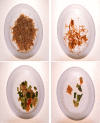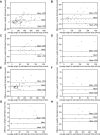Evaluation of a photographic food atlas as a tool for quantifying food portion size in the United Arab Emirates
- PMID: 29698434
- PMCID: PMC5919643
- DOI: 10.1371/journal.pone.0196389
Evaluation of a photographic food atlas as a tool for quantifying food portion size in the United Arab Emirates
Abstract
Although, United Arab Emirates (UAE) has one of the highest prevalence of overweight, obesity and type 2 diabetes in the world, however, validated dietary assessment aids to estimate food intake of individuals and populations in the UAE are currently lacking. We conducted two observational studies to evaluate the accuracy of a photographic food atlas which was developed as a tool for food portion size estimation in the UAE. The UAE Food Atlas presents eight portion sizes for each food. Study 1 involved portion size estimations of 13 food items consumed during the previous day. Study 2 involved portion size estimations of nine food items immediately after consumption. Differences between the food portion sizes estimated from the photographs and the weighed food portions (estimation error), as well as the percentage differences relative to the weighed food portion for each tested food item were calculated. Four of the evaluated food items were underestimated (by -8.9% to -18.4%), while nine were overestimated (by 9.5% to 90.9%) in Study 1. Moreover, there were significant differences between estimated and eaten food portions for eight food items (P<0.05). In Study 2, one food item was underestimated (-8.1%) while eight were overestimated (range 2.52% to 82.1%). Furthermore, there were significant differences between estimated and eaten food portions (P<0.05) for six food items. The limits of agreement between the estimated and consumed food portion size were wide indicating a large variability in food portion estimation errors. These reported findings highlight the need for further developments of the UAE Food Atlas to improve the accuracy of food portion size intake estimations in dietary assessments. Additionally, recalling food portions from the previous day did not seem to increase food portion estimation errors in this study.
Conflict of interest statement
Figures



Similar articles
-
An evaluation of a colour food photography atlas as a tool for quantifying food portion size in epidemiological dietary surveys.Eur J Clin Nutr. 2005 Aug;59(8):923-31. doi: 10.1038/sj.ejcn.1602162. Eur J Clin Nutr. 2005. PMID: 15928683
-
Development and validation of a food photography manual, as a tool for estimation of food portion size in epidemiological dietary surveys in Tunisia.Libyan J Med. 2016 Aug 31;11:32676. doi: 10.3402/ljm.v11.32676. eCollection 2016. Libyan J Med. 2016. PMID: 27585631 Free PMC article.
-
Development and validation of a photographic food atlas for portion size assessment in the southern plains of Nepal.Public Health Nutr. 2016 Oct;19(14):2495-507. doi: 10.1017/S1368980016000537. Epub 2016 Mar 21. Public Health Nutr. 2016. PMID: 26996822 Free PMC article.
-
A systematic review of recall errors associated with portion size estimation aids in children.Appetite. 2020 Apr 1;147:104522. doi: 10.1016/j.appet.2019.104522. Epub 2019 Nov 18. Appetite. 2020. PMID: 31751634
-
Design and validation of a photographic atlas of Peruvian foods to evaluate the food consumption of children from 6 to 12 months of age.Appetite. 2024 Nov 1;202:107611. doi: 10.1016/j.appet.2024.107611. Epub 2024 Jul 27. Appetite. 2024. PMID: 39074616 Review.
Cited by
-
Accuracy of estimates of serving size using digitally displayed food photographs among Japanese adults.J Nutr Sci. 2022 Nov 24;11:e105. doi: 10.1017/jns.2022.102. eCollection 2022. J Nutr Sci. 2022. PMID: 36452397 Free PMC article.
-
Development and validation of a photographic atlas of food portions for accurate quantification of dietary intakes in China.J Hum Nutr Diet. 2021 Jun;34(3):604-615. doi: 10.1111/jhn.12844. Epub 2021 Jan 6. J Hum Nutr Diet. 2021. PMID: 33406287 Free PMC article.
-
Comprehensive global review and methodological framework for developing food atlases.Front Nutr. 2024 Nov 22;11:1505606. doi: 10.3389/fnut.2024.1505606. eCollection 2024. Front Nutr. 2024. PMID: 39650713 Free PMC article. Review.
-
Development of a Digital Photographic Food Atlas as a Portion Size Estimation Aid in Japan.Nutrients. 2022 May 26;14(11):2218. doi: 10.3390/nu14112218. Nutrients. 2022. PMID: 35684017 Free PMC article.
-
Development and validation of a photographic food atlas of Middle Eastern Mediterranean diet: Toward improved understanding of traditional healthy and sustainable diets.Front Nutr. 2023 Jan 11;9:982420. doi: 10.3389/fnut.2022.982420. eCollection 2022. Front Nutr. 2023. PMID: 36712511 Free PMC article.
References
-
- Ng SW, Zaghloul S, Ali HI, Harrison G, Popkin BM. The prevalence and trends of overweight, obesity and nutrition-related non-communicable diseases in the Arabian Gulf States. Obes Rev. 2011;12(1):1–13. doi: 10.1111/j.1467-789X.2010.00750.x - DOI - PubMed
-
- HAAD. Health Authority of Abu Dhabi Statistics Report; 2015. https://www.haad.ae/HAAD/LinkClick.aspx?fileticket=gzx_WUkD27Y%3d&tabid=...
-
- Wolper C, Heshka S, Heymsfield S. Measuring food intake: an overview In: Allison DB,editor. Handbook of assessment methods for eating behaviors and weight-related problems: measures, theory, and research. Thousand Oaks, CA: SAGE Publishing; 1995. p. 215–40.
-
- Robinson F, Morritz W, McGuiness P, Hackett AF. A study of the use of a photographic food atlas to estimate served and self-served portion sizes. J Hum Nutr Diet. 1997;10:117–24.
-
- Nelson M, Atkinson M, Darbyshire S. Food photography II: use of food photographs for estimating portion size and the nutrient content of meals. Br J Nutr. 1996;76(1):31–49. - PubMed
Publication types
MeSH terms
LinkOut - more resources
Full Text Sources
Other Literature Sources

